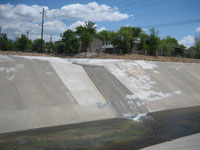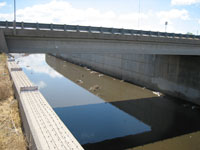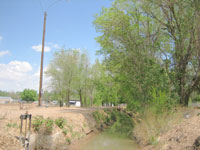I did a couple of water-themed bike rides this weekend, one intentional and one accidental.
I didn’t have the camera with me today, so you’ll have to take my word for it, but my chums and I rode up to the snow on the east side of the Sandias. By the cheap altimeter on my bike computer, it was at 8,400 feet (~2500 meters), a few patches of snow on the north-facing slopes. Given that this has been the driest winter here, and one of the warmest, since forever, I can only assume it was cold enough up there to have snowed while we were getting those few showers Friday and Saturday. It won’t be there long. My bike gizmo said it was 71 degrees F up there (22 C).
The water piece of that ride was accidental. Who knew we’d see snow?
But Saturday, I set out in search of it, riding up along the city’s flood control channels to see what ends up in our river after the first rain in a long time. It wasn’t pretty.
For those not familiar with Albuquerque’s geography, a large portion of the city spreads east from the Rio Grande toward the Sandia Mountains, neighborhoods built across old alluvial fans. The geomorphological implication is that water flowed across them once, but no more. A network of concrete channels has been built that funnels all of the area’s runoff into one big concrete drain that runs the length of town, dumping its contents into the Rio Grande at the north end of town.
There are no permanent streams, but even when it’s dry, there’s always a bit of water in the drain, runoff from leaky sprinklers and car washes and the like. When it rains, especially the first rain after a dry spell, the drain funnels off a toxic soup of ground up lead wheel weights, motor oil, lawn care products, etc. The term of art for this is “non point source pollution.”
The first picture is the water coming out of one of the laterals into the main drain. It looked pretty clean, but as I rode up along the drain I could see more and more crud. But the time I got to the spot where the drain turns into the river (second picture), it was icky. You can see from the hydrograph that it peaked at around 200 cubic feet per second Saturday morning, but the pulse didn’t last long.
Mission accomplished, I wandered back through the north valley, which created a strange sort of cognitive dissonance. That’s the third picture. Remember this is a desert, and that we’ve had 0.41 inches of rain in the last six months. And yet the valley’s lush. Ditches are running full, people are irrigating their acreage, the trees along the ditchbanks are transpiring like there’s no tomorrow. An odd site in the desert.



